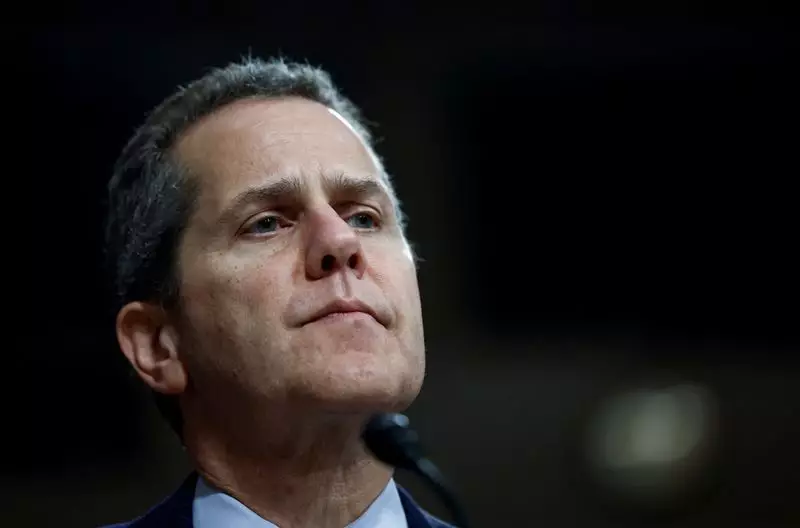In a notable development for the U.S. financial landscape, Michael Barr has announced his resignation from his role as the Federal Reserve’s vice chair for supervision, effective February 28. This move marks a significant pivot, particularly as it opens the door for President-elect Donald Trump to nominate a successor who aligns more closely with a pro-business regulatory philosophy. Barr’s departure hints at deeper undercurrents in the relationship between the Fed, bank regulators, and the incoming administration.
Barr’s early exit from a position that was not set to expire until July 2026 points to the potential for political turbulence surrounding his relationship with the forthcoming administration. While many viewed Barr as an apolitical figure focused on regulatory integrity, the changing political tides rendered his position precarious. By choosing to step down voluntarily, Barr has avoided a combative confrontation that could have escalated into a contentious legal battle. In his statement, Barr acknowledged the “risk of dispute” as a distraction from the core objectives of the Fed, suggesting a desire to maintain institutional focus amidst shifting political tides.
The choice to remain on the Fed’s Board of Governors preserves his influence but also creates a duality in his role. This will likely restrict Trump’s flexibility in appointing someone who may expedite a deregulation agenda. As it stands, there are no vacant seats on the Board, meaning any new regulatory appointee must come from within the existing governance structure.
The search for Barr’s successor will garner significant attention, particularly from the financial lobby eager to install a figuremore aligned with their interests. Candidates such as Fed Governor Michelle Bowman and Christopher Waller are being discussed as potential replacements. Both have shown tendencies that may align more consistently with banking interests, suggesting a shift away from the tougher regulatory stance that characterized Barr’s tenure.
The implications of this transition could be far-reaching. Under Barr’s oversight, the Fed embarked on several initiatives aimed at instilling rigorous regulations on major banks, particularly in response to concerns that arose from past financial crises. The push for the so-called “Basel III Endgame,” which sought to implement stricter capital requirements for large banking institutions, faced fierce resistance from the financial services lobby. As Barr’s regulatory framework comes under reassessment, there is a palpable sense that his efforts to recalibrate the banking sector’s risk assessments may be undermined or even abandoned entirely.
Financial markets reacted promptly to Barr’s announcement, with major U.S. banks seeing a notable uptick in their stock prices. Citigroup led the surge, with shares climbing nearly 4%, while other large banks such as Bank of America and Wells Fargo followed suit. This response signals optimism among investors regarding the possibility of a more lenient regulatory environment under Trump’s administration.
However, such optimism must be tempered with a degree of caution. The need for regulatory vigilance remains vital in the context of sustaining the financial stability of the U.S. economy. Many financial experts and analysts are wary of the implications that a repeal of stricter regulations could pose, particularly concerning the systemic risks that were illustrated during the 2008 financial crisis. The balancing act between fostering economic growth and ensuring robust oversight will undoubtedly remain a pivotal issue as new regulators begin to shape the future landscape.
Barr’s departure also comes amidst a broader dialogue about the independence of the Federal Reserve. With Trump’s administration appearing intent on exerting greater influence over the Fed, concerns have emerged regarding the potential erosion of the central bank’s autonomy. Such a phenomenon could lead to shifts in monetary policy that prioritize short-term political gains over longer-term economic stability.
Under the current legal framework, while the president has the authority to nominate governors, they can only be dismissed for cause. The conversation surrounding Barr’s potential replacement is marred by political implications, suggesting that the prioritization of uninhibited regulatory pursuits may be at stake. Fed Chair Jerome Powell, who also navigated the complexities of Trump’s previous presidency, will henceforth play a crucial role in maintaining the integrity and independence of the Fed amidst political pressures.
Michael Barr’s resignation represents more than a mere personnel shift; it embodies a critical juncture in U.S. banking regulation amid changing political landscapes. The forthcoming appointment of a new vice chair for supervision could tilt the balance of power in favor of the banking industry, sparking contentious debates on regulatory efficacy and the need for vigilance. As stakeholders monitor the selection process closely, the broader ramifications for the financial sector and the U.S. economy remain to unfold.

